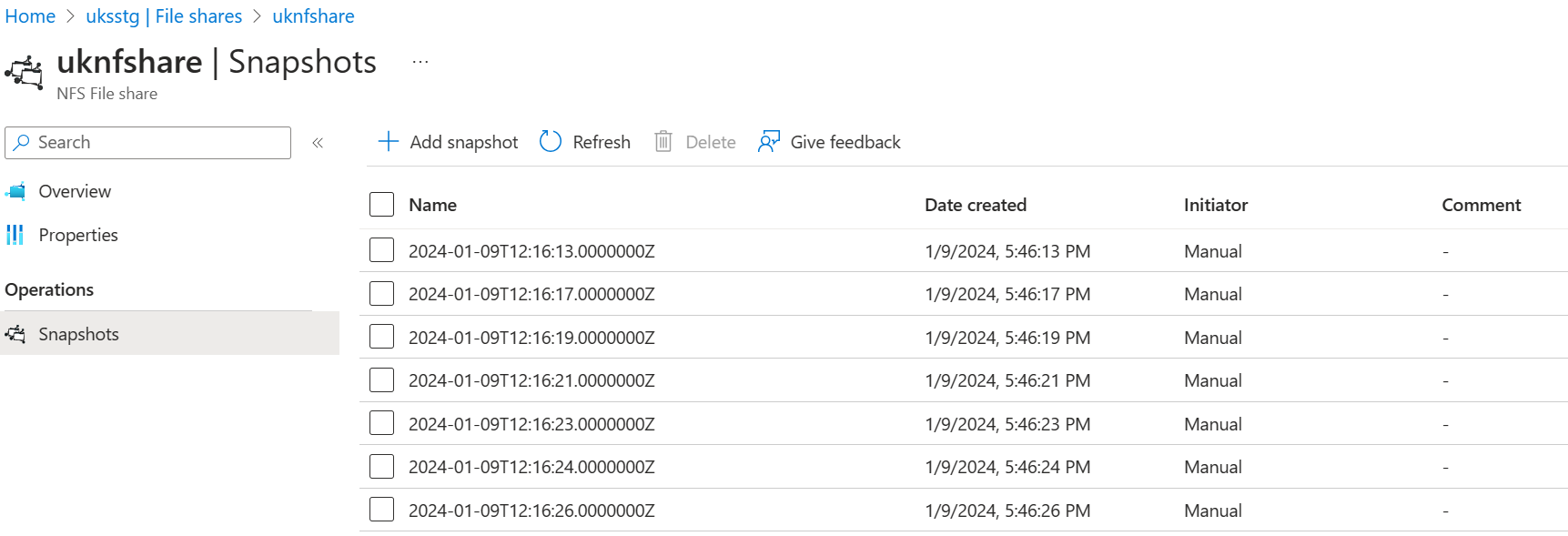Announcing the general availability of NFS Azure file share snapshots

Azure Files is offered as a fully managed file share service in Azure cloud. Azure file shares can be mounted via SMB (Server Message Block) and NFS (Network file System) protocols on clients running either on-premises or in the cloud.
We first made snapshot support available for SMB Azure file shares, and since then we’ve seen many of our customers and partners reaping the benefits of having point-in-time copies of their production data. In late 2023, we announced the Public preview of snapshot support for NFS Azure file shares. With this blog, I’m excited to announce General availability (GA) of snapshot support for NFS Azure file shares.
File share backups are critical to every organization's data protection strategy. Even though snapshots aren’t considered backups in the traditional sense, they’re generally seen as a complementary approach in mitigating data protection challenges. Customers rely on technologies like snapshots and replication to deliver on lower recovery point objective (RPO) and recovery time objective (RTO) SLAs compared to traditional backup technologies. In this blog, I’ll talk about how NFS Azure file share snapshots can complement your existing backups and strengthen your overall data protection solution.
When to use?
Prevent accidental data loss
Data loss via accidental deletions or by malicious admins is a common scenario that customers must protect against. Having point-in-time snapshots will allow users to recover lost data at a file-level granularity. Because snapshots are read-only, the data within the share is immutable by design.
Protect against upgrade failures
Imagine running a production upgrade, and due to some issue or bug, it fails. Having snapshots in such scenarios will enable customers to roll back production to a previous point in time without impacting business.
Fast and frequent copies of production data at a lower RPO and lower cost
Unlike traditional backups, snapshots don’t create a full copy of data. Only changes made to the file share are stored in the snapshot. If nothing changes after you create the snapshot, the size of the snapshot remains zero. This makes snapshots space and cost efficient. It also minimizes the time required to create the snapshot. Customers can create a snapshot of the share instantaneously and frequently to improve RPO.
Customers can also restore snapshot data to an alternate location to create a copy of production datasets for various scenarios such as test and development, reporting, and risk analytics without impacting production performance.
How to get started?
NFS Azure file share snapshots can be created, managed, and deleted via the Azure portal, Azure PowerShell, Azure CLI, and REST API.
Sample scripts to automate the creation and deletion of snapshots are available here.
Azure Files GitHub samples repository
The REST API interface enables third-party applications to integrate with file share snapshots to build seamless and automated management workflows.
Restoring from a snapshot is a simple two-step process.
- Mount the snapshot on the NFS client.
- Copy the content from the snapshot using native file system copy tools to the desired destination.
To learn more, please refer to Overview of share snapshots for Azure Files | Microsoft Learn.
Published on:
Learn moreRelated posts
Automating Business PDFs Using Azure Document Intelligence and Power Automate
In today’s data-driven enterprises, critical business information often arrives in the form of PDFs—bank statements, invoices, policy document...
Azure Developer CLI (azd) Dec 2025 – Extensions Enhancements, Foundry Rebranding, and Azure Pipelines Improvements
This post announces the December release of the Azure Developer CLI (`azd`). The post Azure Developer CLI (azd) Dec 2025 – Extensions En...
Unlock the power of distributed graph databases with JanusGraph and Azure Apache Cassandra
Connecting the Dots: How Graph Databases Drive Innovation In today’s data-rich world, organizations face challenges that go beyond simple tabl...
Azure Boards integration with GitHub Copilot
A few months ago we introduced the Azure Boards integration with GitHub Copilot in private preview. The goal was simple: allow teams to take a...
Microsoft Dataverse – Monitor batch workloads with Azure Monitor Application Insights
We are announcing the ability to monitor batch workload telemetry in Azure Monitor Application Insights for finance and operations apps in Mic...
Copilot Studio: Connect An Azure SQL Database As Knowledge
Copilot Studio can connect to an Azure SQL database and use its structured data as ... The post Copilot Studio: Connect An Azure SQL Database ...
Retirement of Global Personal Access Tokens in Azure DevOps
In the new year, we’ll be retiring the Global Personal Access Token (PAT) type in Azure DevOps. Global PATs allow users to authenticate across...
Azure Cosmos DB vNext Emulator: Query and Observability Enhancements
The Azure Cosmos DB Linux-based vNext emulator (preview) is a local version of the Azure Cosmos DB service that runs as a Docker container on ...
